If you’ve read my article in April’s edition of the Total Football Analysis Magazine, you’ll know that I point to the lack of runs behind the defence as one of the underlying reasons for Real Madrid’s struggles.
While the talent level of the front three has dropped considerably from the heights of the BBC, opponents are keeping Madrid’s attacks in front of them.
Without the need to frequently scan for Madrid’s attackers, track runners and regain their defensive shape, opponents are gladly embracing Real’s predictable attacks.
When you have a forward like Benzema, who enjoys dropping into the midfield to participate in the build-up, those two wide forwards need to test the backline by running into the space Benzema’s created.
Without those runs, gaps are left unexploited and the backline comfortable within their structure.
In this training article, I’ll start with a tactical analysis of the benefits of running in behind the defence.
From there, we’ll look at different exercises for training these runs and some of the coaching points you’ll have to address.
This is the first of two pieces on the topic.
At present, we’ll break down runs in behind the defence within a single or three forward system.
For the sake of simplicity, I will refer to three forwards systems in this article, though most single forward tactics will incorporate high, wide wingers who fill the function of wide forwards, leading to a degree of equivalence.
Next week, the focus will runs behind the defence with tactics featuring two forwards.
Why are runs in behind significant in a front three?
Within a three forward system, the highest line must occupy and disorganize the opposition’s backline.
Since the back four is most common, we’ll primarily concern ourselves with that structure.
In terms of numbers, the backline will generally operate from a plus-one advantage.
Therefore, front three systems require activity from the forwards, stretching them vertically and horizontally to create gaps for exploitation.
A club’s tactical #9, also known as the striker or centre-forward, plays a major role in determining the success of the line.
With opponents to either side of the #9, he’ll attempt to command the attention of both centre-backs, switching from one to the other or playing in the gap between them to free up space for the wide forwards.
The specific tactical instructions will vary to fit the skill set of the player.
Those with more pace might primarily look to make driving vertical runs, whereas your typical #9 in a three forward system will generally lack top-end pace while offering size and strength as an outlet.
Even among the latter class of #9s, there are variations of approach, which is largely down to the ability of the striker.
If your man up top is less technical or severely lacking in mobility, you’ll nearly always find him more central.
His contribution is committing both centre-backs to the central channel, creating more room in the half-spaces and winger for his teammates.
While the centre-backs remain connected with each other, they sacrifice connectivity with their wide defenders.
With a player like Benzema, he’ll bounce between the two forwards, but, in that transitional moment from attacking the opponent to attacking the goal, he wants to disconnect one centre-backs from everyone else on that line.
By pulling that central-defender out of his line, a massive gap between the outside-back and other centre-back emerges.
Wide forwards who see the opportunity and make the run will then find themselves 1v1 with the remaining centre-back or through to goal.
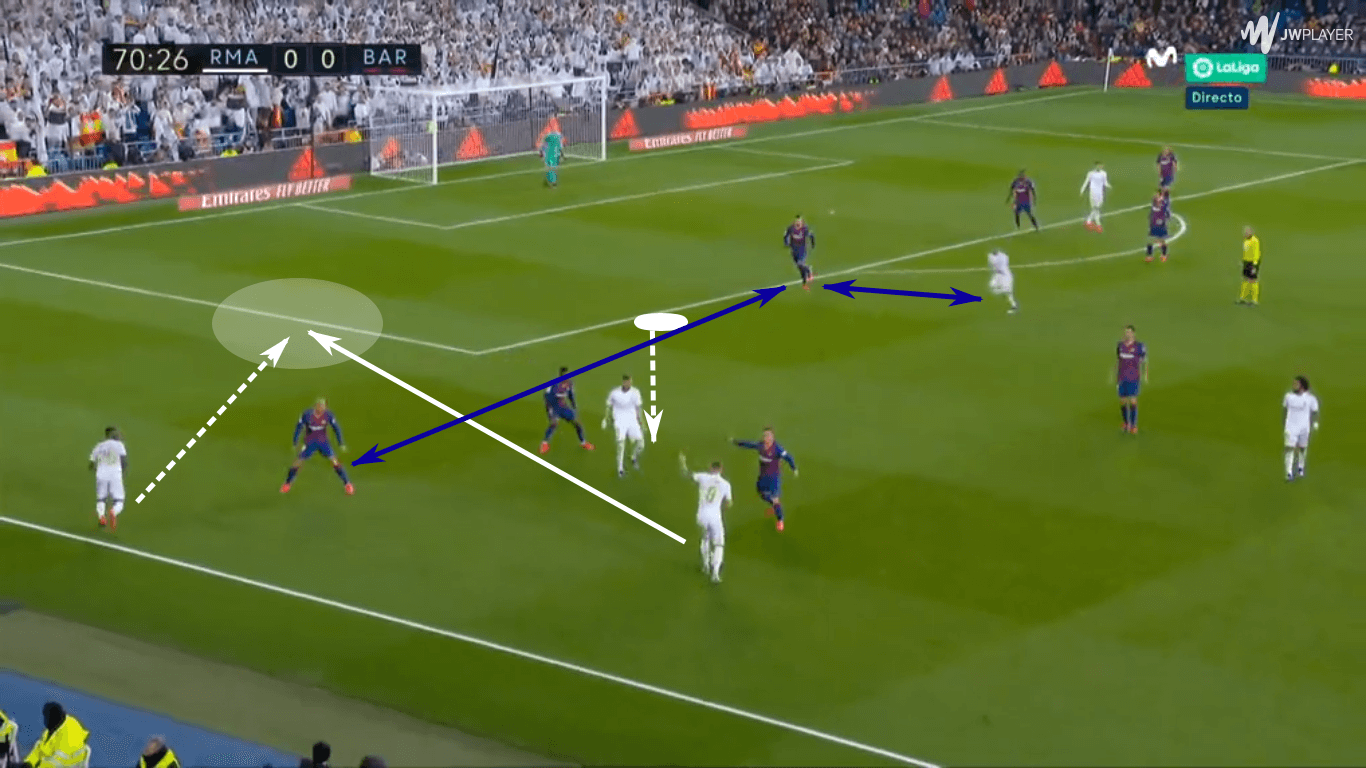
In the most recent Clásico, the game-winning goal was the product of a nice sequence on Real Madrid’s left-wing.
Benzema dropped deep from his position in the half-space.
As he checked to Toni Kroos, Gerard Piqué remained deep to pick up the incoming runner.
That left Nelson Semedo to pick up Benzema and Martin Braithwaite defend against Vinícius Júnior.
The young Brazilian was slow to read the movement of Benzema and the consequent gap in the defence.
Kroos signalled his teammate to make the run, releasing him behind Braithwaite and onto goal.
With Piqué forced to mark the central runner, Vinícius Júnior had a clear path the goal, sealing the victory for Madrid.
Though he walks away without any statistical credit for the goal, Benzema’s ability to pull Semedo out of the backline, preventing him from covering Braithwaite, created the lane that initiated the move towards goal.
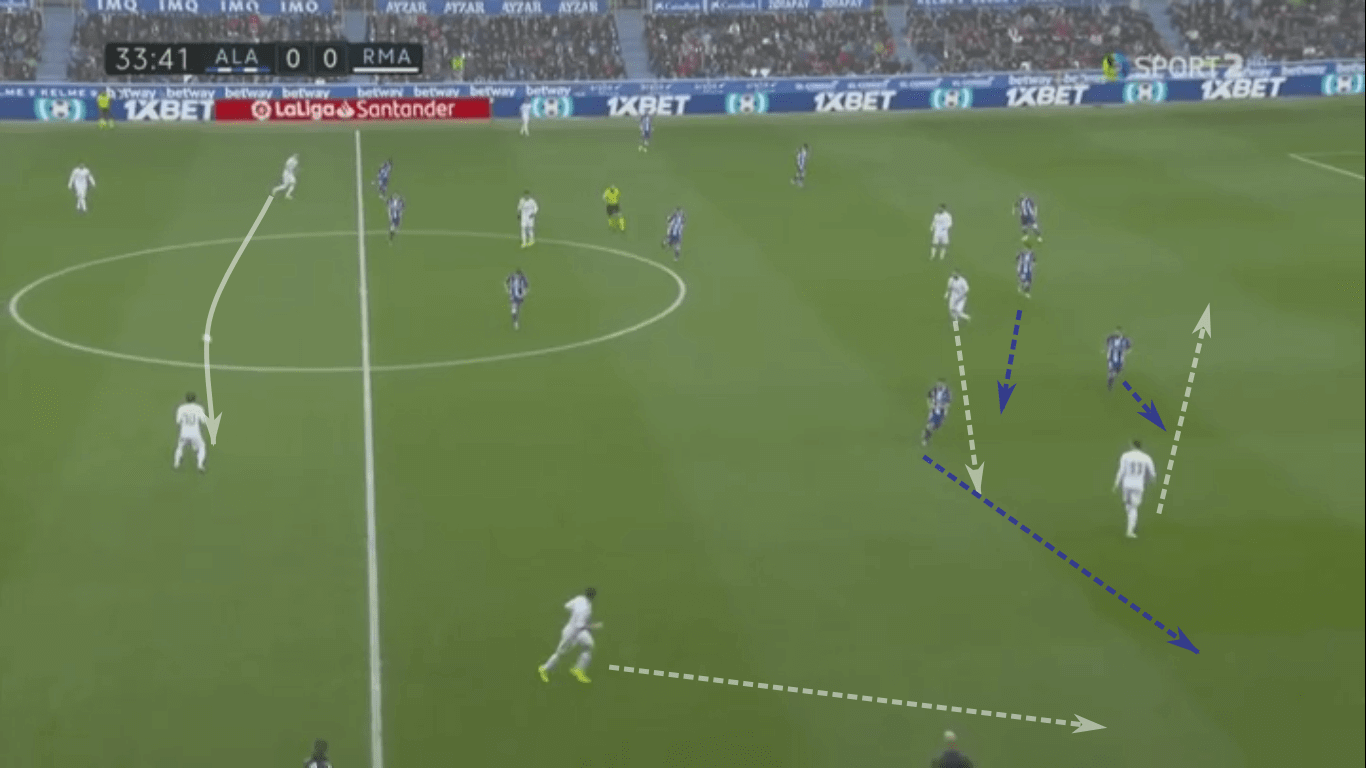
Against Deportivo Alavés, Kroos completed the switch of play to Luka Modrić, cueing movement in the right-half of the pitch.
As Dani Carvajal pushed up the pitch, Benzema against dropped deep, this time taking a centre-back with him.
Bale knows that Carvajal is pushing up the wing, so he’s primarily watching the movement of Benzema, waiting to see how the backline responds.
As the centre-back track Benz, Bale starts his diagonal run to goal.
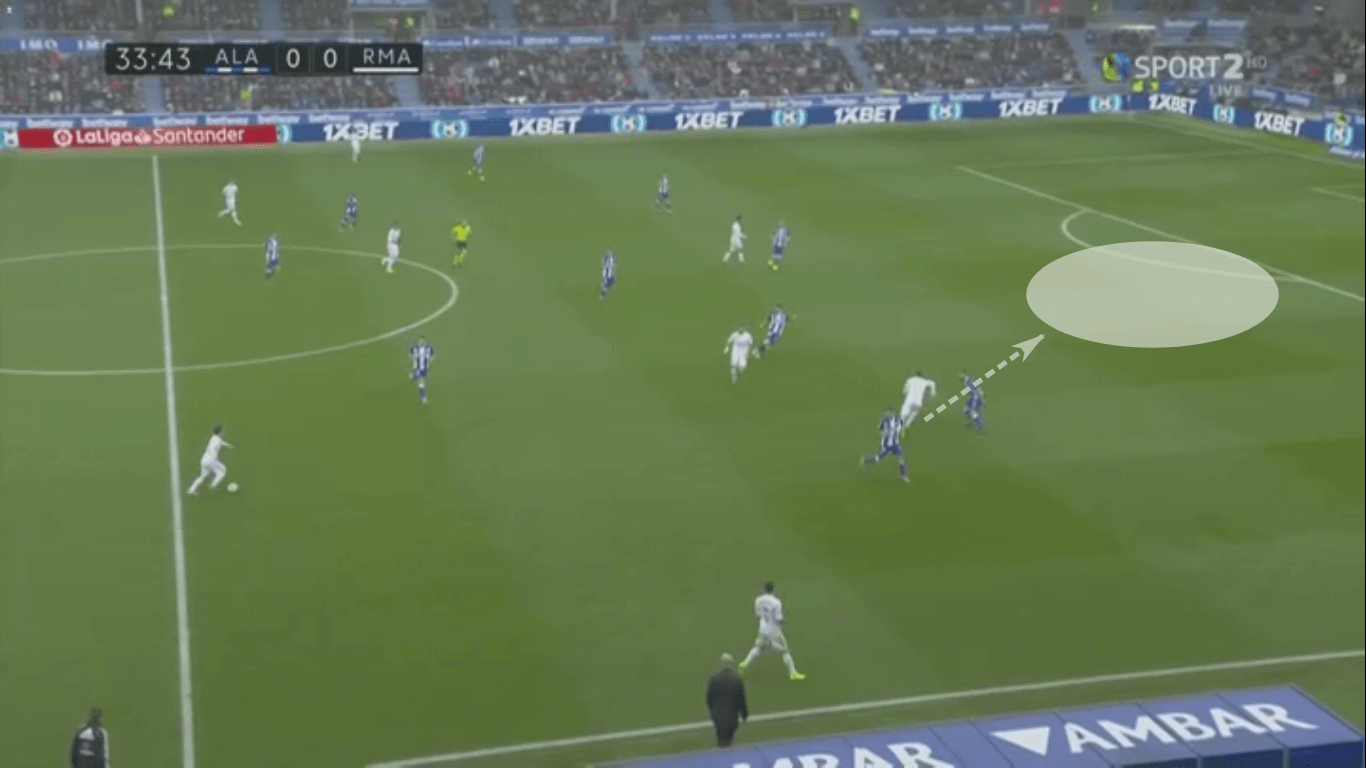
Modrić didn’t see the play in time and opted to play wide to Carvajal.
However, the interaction between Benzema and Bale highlights the movement we want.
As you can see in the picture, the centre-back has just realized his mistake and starts to backtrack.
While Bale is still a couple of metres in front of the left-back, his opponent has poor body orientation, so the Welshman wins that footrace with plenty to spare.
Intelligent wingers will always look to play off of their centre-forwards, watching for cues on when and where to run.
Bale’s run behind the line was spot-on, but, unfortunately, unrewarded.
Outside-in runs
While the previous section focused on the centre-forward’s role in setting up his teammates’ runs, this next area is dedicated to the runs of the winger.
A front three only works if the wingers are goal-hungry and willing to make the physical sacrifices that come with sprints behind the backline.
If they prefer to receive each pass to their feet, the defence can retain its shape and wait to engage 1v1 knowing that it has adequate second defender coverage.
As mentioned in the previous section, wingers must read the movements of their centre-forwards and look for the right opportunities to run in behind.
That said, not all forwards drop into the midfield and defenders don’t always track those runs.
Fortunately for wide forwards, their runs aren’t always dependant on the movement of the centre-forwards.
In the flow of play, wide forwards are often isolated with the opposing outside-back.
That isolation presents an opportunity.
If the defender stays more central, connected the nearer of his two centre-backs, the winger can offer an outlet around the defence or make horizontal or diagonal runs onto through passes.
If the defender doesn’t move wide with the forward, he will at some point lose track of his mark.
That loss of focus, combined with a forward-facing teammate in possession of the ball, is an opportunity for that horizontal or diagonal run.
If the defender goes with the forward, the running lane is rather obvious.
The moment a defender shifts his glance away from the forward, it’s time to go.
This can happen in counterattacking situations too.
A “V” run can pull the defender further wide and shift his momentum away from the space you want to run into.
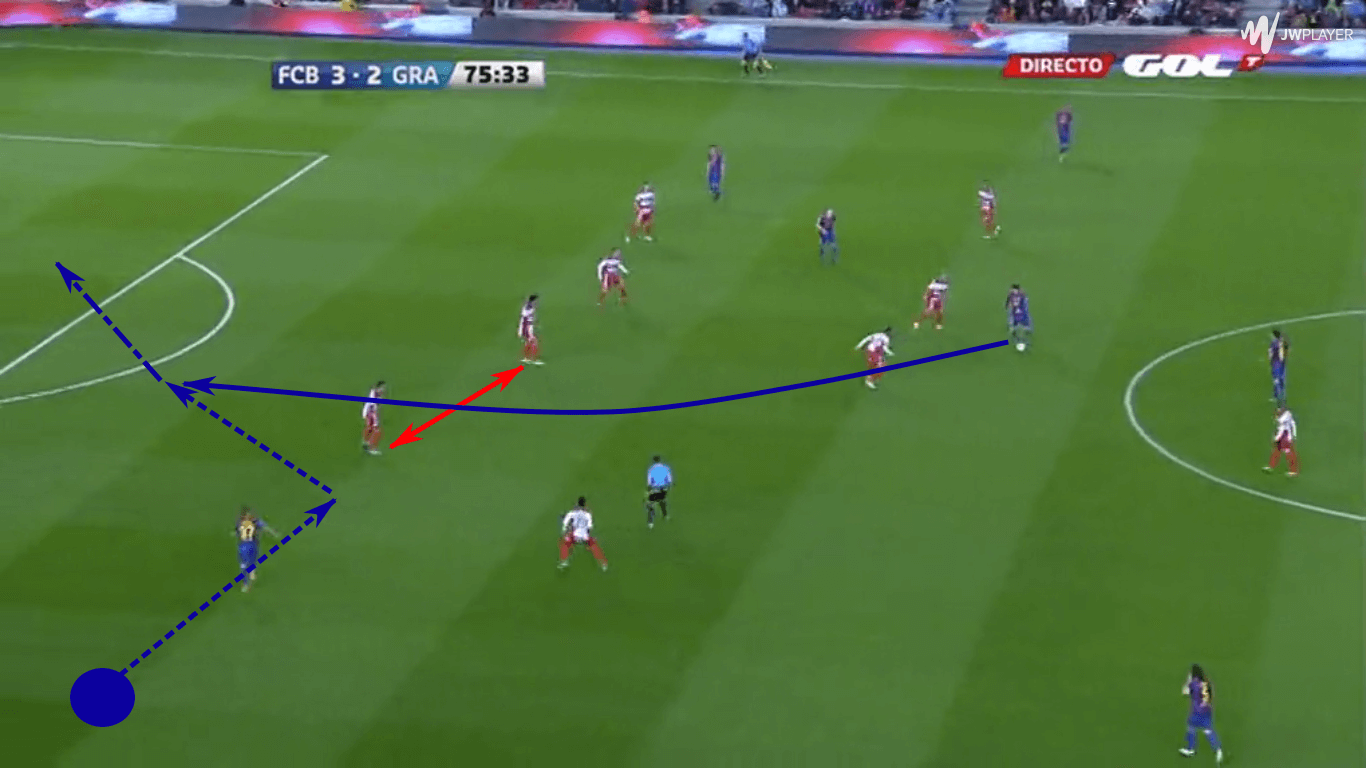
This is one of my favourite sequences for teaching wingers how to run behind the defence.
In a March of 2012 La Liga match against Granada, Cristian Tello had just entered the match and was looking for his goal.
As you’ll recall, opponents played very narrowly against Barcelona at the end of Pep Guardiola’s reign.
Wingers like Tello, David Villa and Pedro frequently started high and wide, but opponents prioritized maintaining their shape, leaving the wingers largely unmarked.
To solve the problem, Barcelona’s wingers used horizontal runs to cue Messi and the Barcelona midfield to play forward.
At the top of the image, you can see the numerical equivalence.
That’s where Barcelona had the ball.
As they found their central outlet, Tello took his opportunity to make the run.
Since he was virtually unmarked, his defender lost track of him and didn’t catch the run in time to end the attack.
The major coaching point here is that, if the defender leaves the winger to stay connected, wait until he’s entirely focused on the ball, then make your run behind him.
With the initial horizontal run, Tello was at run speed while the right-back had to start his recovery from a standstill.
No contest!
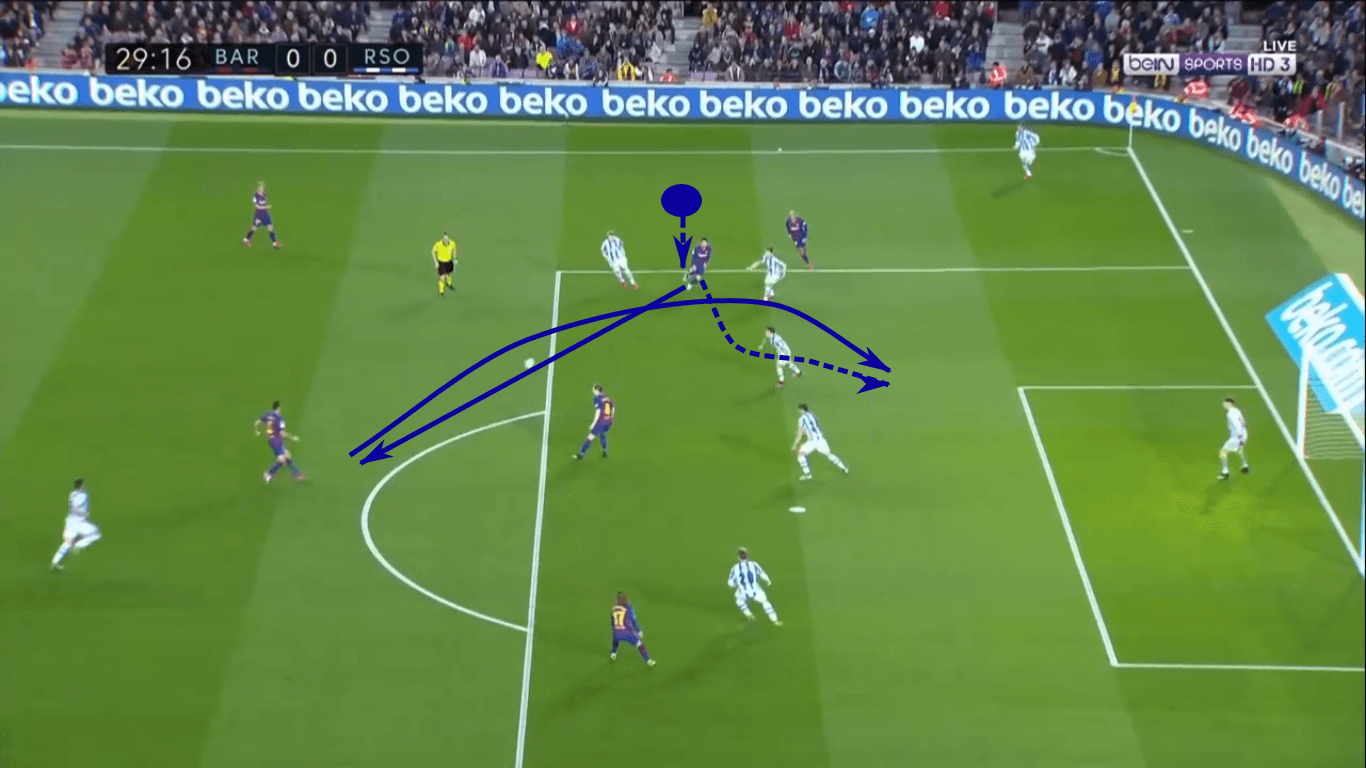
In this sequence from Barcelona’s previous match against Real Sociedad, Messi picked the ball up in the wing and dribbled inside only to meet three defenders.
He played negative to Sergio Busquets, which triggered the forward movement of the defence.
As they moved forward, Messi continued his horizontal run, then cut up the field as Busquets delivered the pass.
Knowing that the defender would move to address the new threat, Messi made a fantastic decision to continue his run.
He knew Real Sociedad wouldn’t track his run because of the numbers Barcelona had in the middle of the box, so he picked his desired angle to goal and nearly gave his side the lead.
Benefits of vertical runs
If you want an example of a team that excels in vertical runs, watch Barcelona.
When they score, you can just about bet a vertical run had a role in the sequence.
When Suárez was healthy, he Messi and Griezmann often took up central starting points.
Many teams will shift their wide forwards into the half-spaces as they prepare to attack the goal.
The obvious benefit is that you have more numbers close to goal.
The issue is that it draws many opponents into that same area, congesting the pitch for the attacking team.
This is when you must use a strength in numbers approach.
If your numbers are central and you’re looking to get someone behind the opponent’s lines, one run likely isn’t enough.
Think about the situation at Barcelona.
Suárez is incredibly active, constantly running behind the lines.
Each run draws a defender, maybe more.
Even if they only track his first few steps, they’re already at a disadvantage.
First, they’ve conceded space to the players behind the first runner.
Second, they then have to quickly make up that ground.
An intelligent, opportunistic attacker will watch for that recovery run, then dart into the space the opponent has conceded.
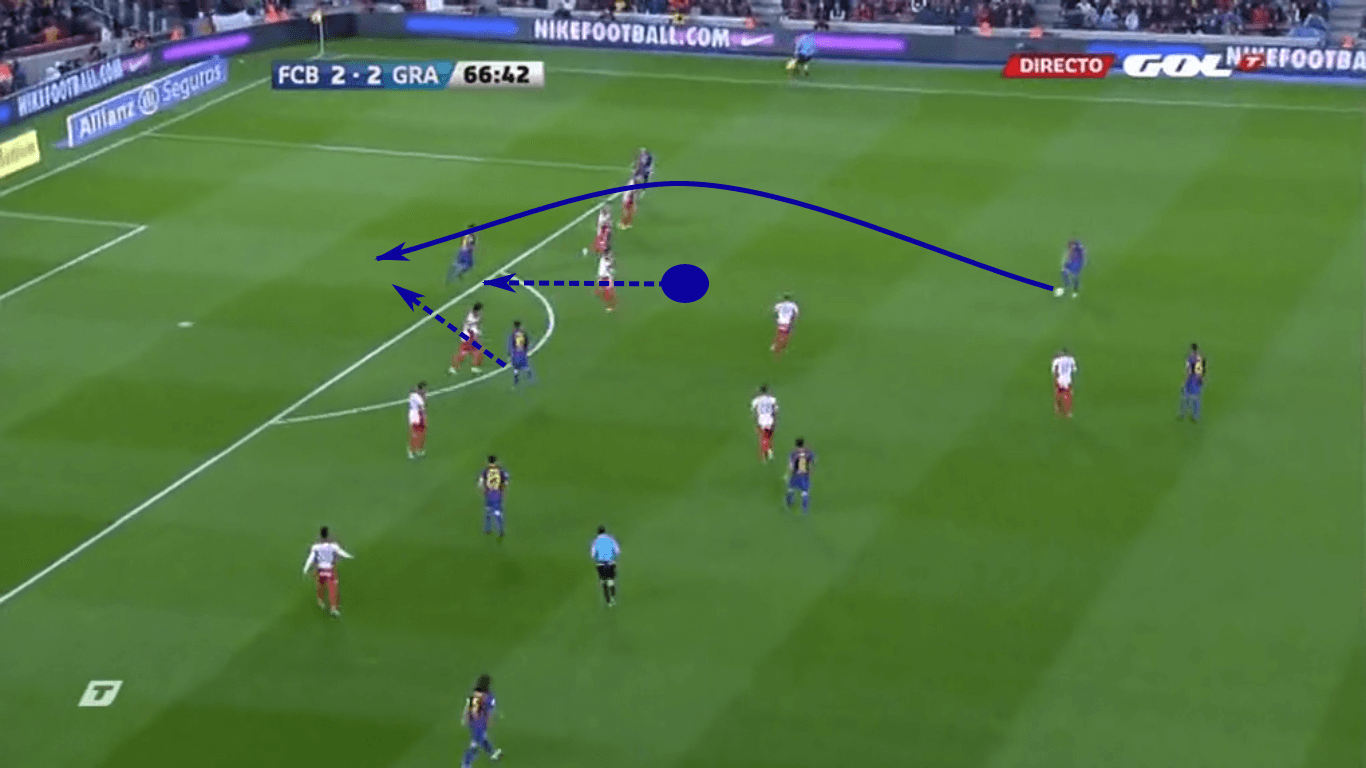
Going back to that match against Granada in 2012, Barcelona made an initial vertical run in the central channel.
Though the pass wasn’t played, it did force the Grenada defenders back.
As they released the runner and pushed higher up the pitch, Messi saw his chance.
With Dani Alves facing forward with time to pick out a runner, Messi darted into the newly available space.
Alves hit a perfect chip over the top, assisting Messi on the goal that made him Barcelona’s all-time leading scorer.
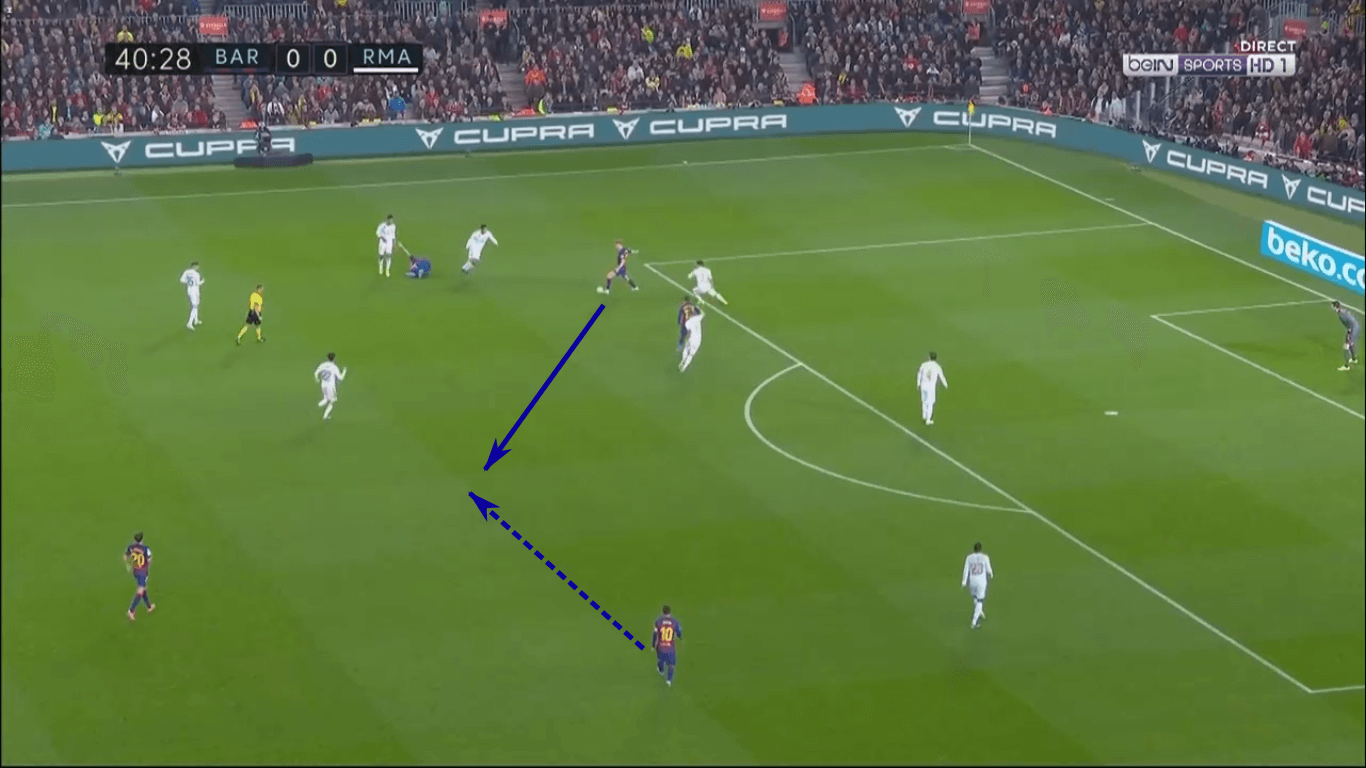
In another example of runs from the centre of the pitch, we have a sequence from December’s Clásico.
Frenkie de Jong took possession of the ball, cut back and then played negative to Messi.
With Suárez rolling around, begging for medical assistance, Jordi Alba, who is off-screen, started an incredible run to switch off with the Uruguayan.
Note that Madrid’s backline is highly structured at this point and Barcelona do not yet have many players in or near the central channel.
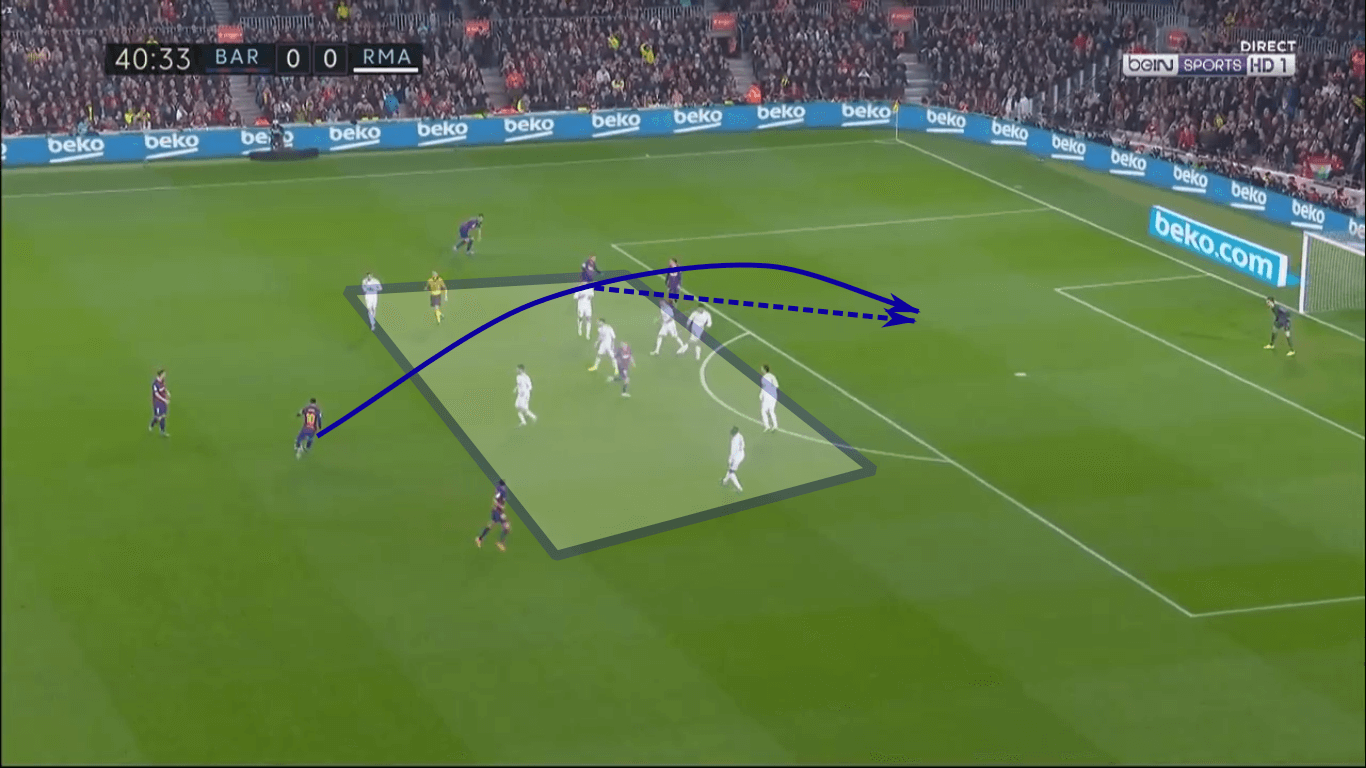
Now, as Alba enters the fray and Sergi Roberto pushes into that white figure, Madrid still has numerical superiority, but they botch the coverage.
If you’re familiar with the bystander effect, you’re aware that individuals are less likely to take action when other people are around and capable of providing the same service.
That’s exactly what happens here.
Real Madrid assume a teammate will pick up the incoming runners, but Alba runs freely through the backline and nearly finished Messi’s chip.
Alba’s commitment to make the run sets up this sequence.
Exercise 1
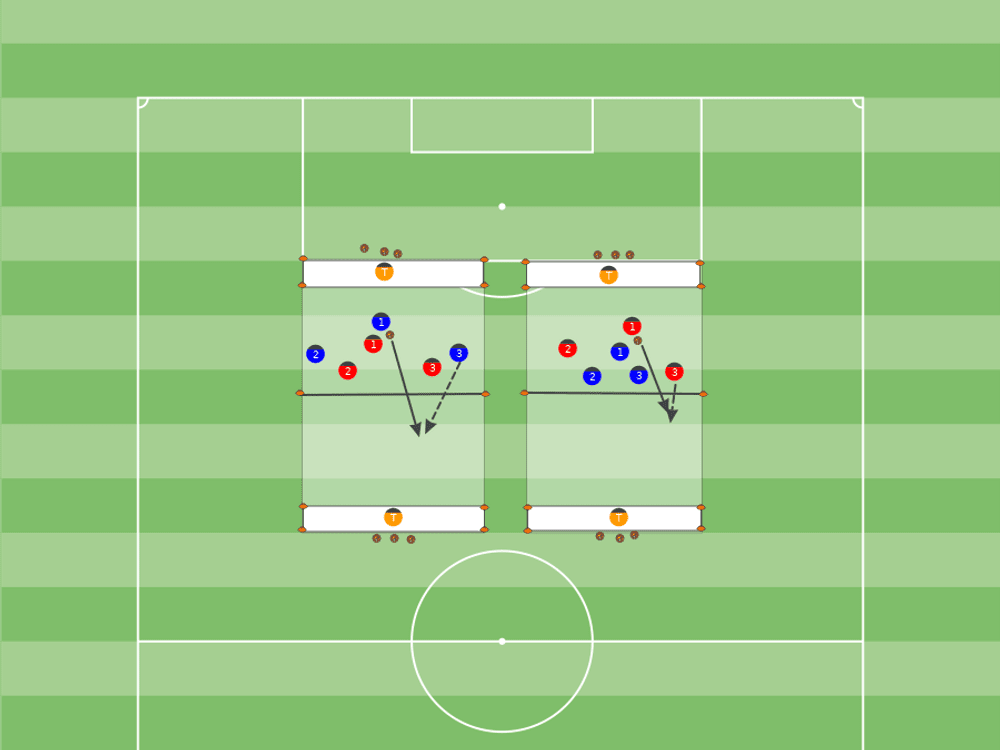
Organization
- Field measures 12v24. Midfield line operates as offside line. Give an additional three metres -depth per endzone.
- Two teams of three with one target player in each endzone.
Gameplay
Before a team can pass to the target player, they must cross midfield with a pass.
The objective is training runs in behind the defence.
Attacking teams must look to play a teammate across midfield, either playing through the defence or around them (as shown in the diagram).
Once a team crosses midfield, they are free to pass to the target player, earning one point.
Ball stays with the scoring team as they simply change the direction of their attack.
This is an ideal warm-up, lasting approximately 15 minutes.
Coaching points
- Correct body orientation to connect actions
- If you can’t play forward, just keep the possession by utilising the deep target player
- Support the player who has positioned himself back to goal (play the high attacker, set, play forward)
- Look for the run as a teammate receives while facing forward
- The run dictates the pass
- Disconnect the defence to create the space you want to attack
Exercise 2
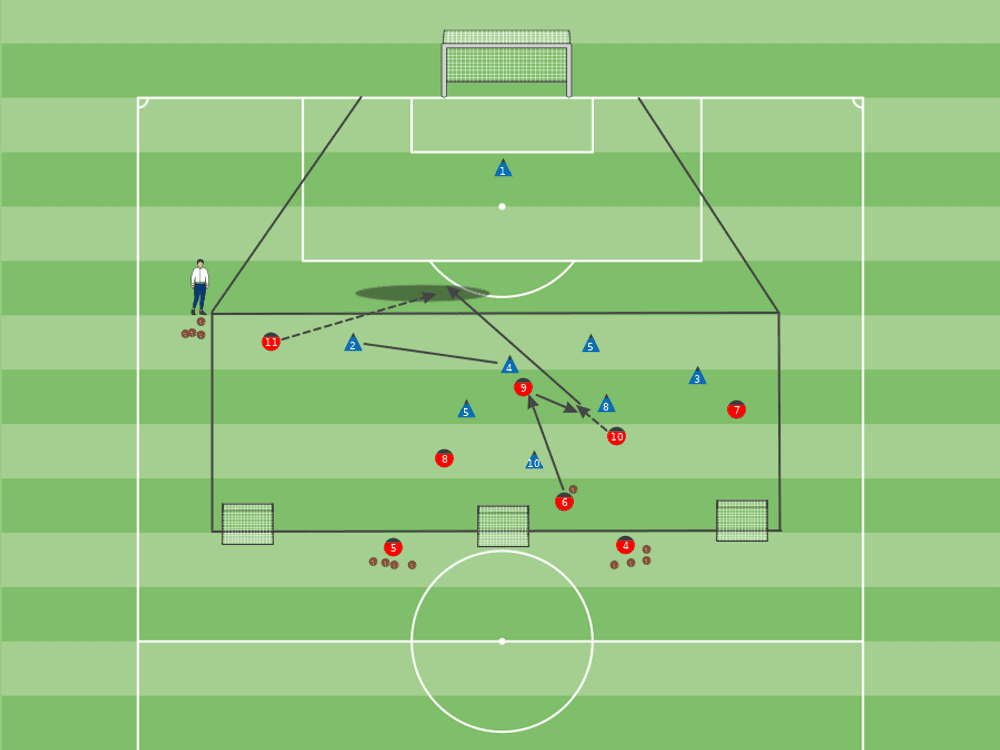
Organization
- 33Wx50L
- Main playing area is 33Wx30L
- Force players to cut inside with the diagonal line 20 metres from the endline to the middle of the half-spaces on the touchline
- 6v6+GK
- Red plays to full-sized goal, blue to three mini goals
Gameplay
A nice progression from the first exercise, the red team must pass out of the primary playing zone to attack the goal.
No dribbling over the line.
I would run this exercise for approximately 25 minutes, giving a one-minute rest after each five minute round.
Coaching points
- All coaching points from the first exercise (look for continuity in the session)
- Vary starting points
- Play between the lines to help create and drag defenders out of their lines
Watch for an understanding of time and run type.
An idea you want to convey is that, when a player, typically a winger, isn’t directly involved in the play, she must attempt to manipulate the positioning of the opposition.
If the opponent goes with her, she’s created space for a diagonal or horizontal run, cueing her teammate to play a through ball.
If the opponent stays narrow, we can look to play around the defence.
Exercise 3
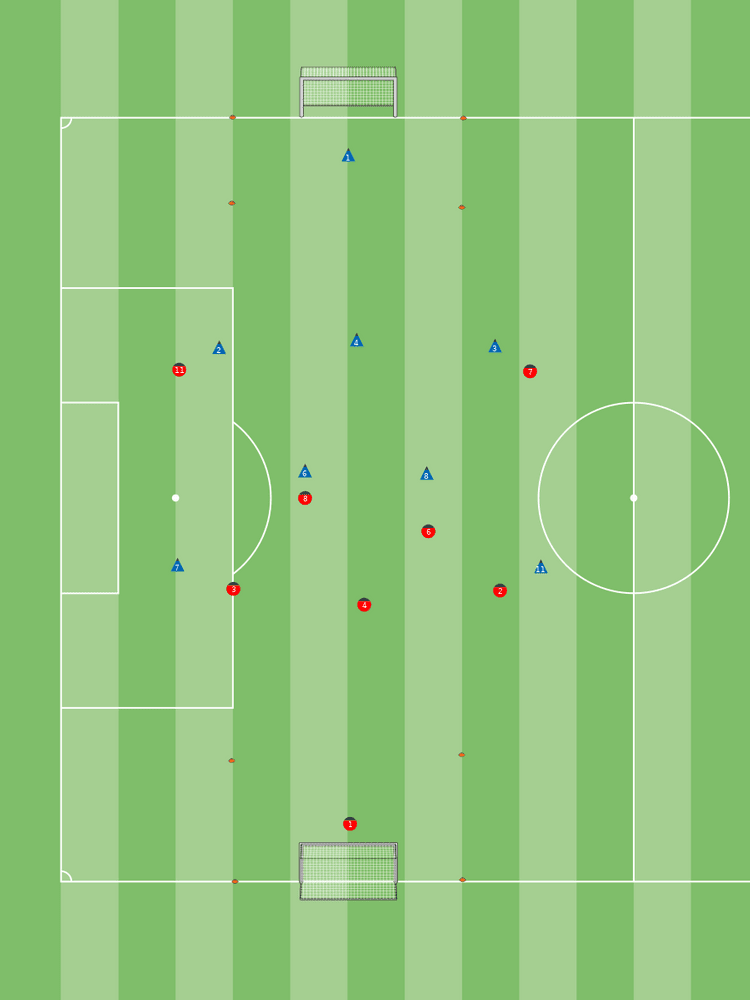
Organization
- Half field, using 9v9 lines if your pitch has them
- 8v8 going to full-sized goals
Gameplay
Give players the freedom to implement the ideas from the session.
Quietly observe and note the concepts that they’ve understood and where the team needs more work.
Let them play for 30 minutes, breaking the exercise into three, eight-minute rounds.
During the breaks, use guided questions to influence their play.
Coaching points
Reinforce all prior coaching points.
Conclusion
As I mentioned at the start, this is the first of two articles dealing with runs behind the defence.
Our focus in this piece was developing an analysis of what those runs should look like from a three forward system.
Having touched on the movements of the central and wide forwards, as well as the interaction between the two groups, we have a better understanding of the ideas we wish to impart to our players.
Before the idea of a successful run is present in their minds, it needs to exist in yours and conveyed in a clear manner.
Teach your players to enjoy the mind games that evolve from these scenarios.
If they can learn to manipulate the position of the opponent or take advantage of a drop in focus, they’ll earn more high-quality scoring opportunities, benefitting themselves and the team.
Additionally, a quick word of thanks to my colleague, Rich Scott, for his assistance in the idea stage of this article.
You’re much appreciated.





Comments